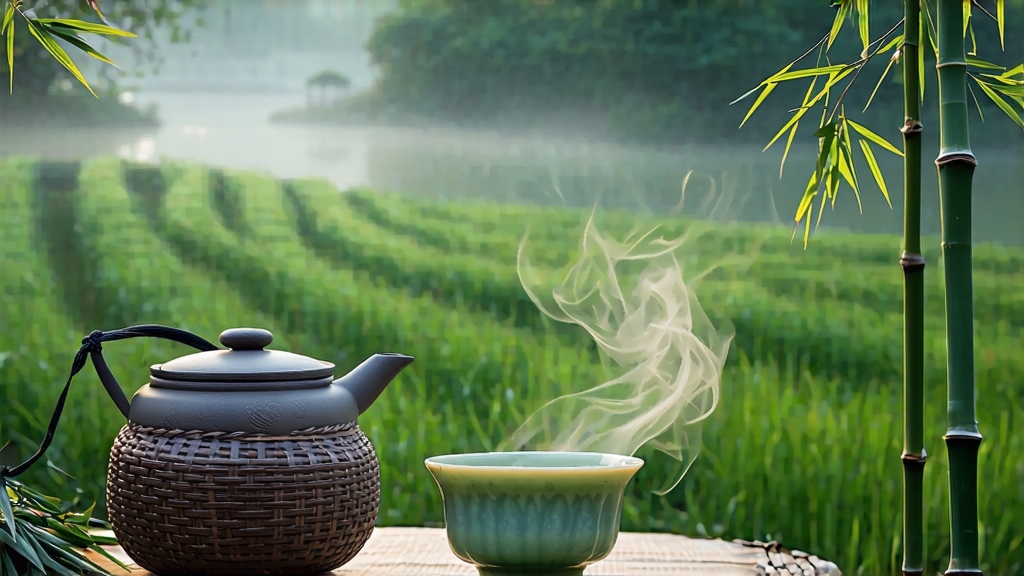
Longjing—literally “Dragon Well”—is not merely a green tea; it is a liquid manuscript of Chinese civilization, a sip of which compresses thirteen centuries of poetry, imperial decree, terroir and craftsmanship into a single, jade-bright cup. To the global palate it offers the gentlest introduction to Chinese green tea, yet to the initiated it is an inexhaustible archive of micro-flavors that shift with every spring. This essay invites the international reader to walk the narrow quartz-strewn paths above West Lake, to hear the crackle of fresh leaves in an iron wok, and to learn why a tea so understated can command prices higher than silver by weight.
-
Historical tapestry
The first credible mention appears in the Tang Dynasty Lü Yan’s “Classic of Tea” (760 CE), but Longjing’s mythic birth is pegged to 250 CE when a Taoist monk is said to have summoned a dragon from a well near today’s Dragon Well Village; the grateful dragon brought rain and left behind a spring whose water, when used for tea, revealed hidden sweetness. By the Song Dynasty the leaves were pressed into dragon-phoenix cakes, yet the leaf style we recognize—flat, spear-shaped, jade-green—emerged during the Ming. The Qianlong Emperor’s 18th-century tour of Hangzhou sealed its fate: after tasting the tea at Lion Peak (Shi Feng) he declared 18 bushes Imperial, wrapping their produce in yellow silk and sending it to Beijing. Those 18 bushes still stand, fenced but alive, their descendants forming the genetic backbone of the cultivars now planted across Zhejiang. -
Micro-terroirs within West Lake
Chinese law protects only 168 km² as authentic “West Lake Longjing.” Within this micro-region five sub-zones are worshipped:- Shi Feng (Lion Peak): granite soil, diurnal swing 10 °C, yields a tea with orchid nose and longest aftertaste.
- Mei Jia Wu: terraced red loam, slightly higher polyphenols, giving a bean-sweet finish.
- Weng Jia Shan: shale-rich, earliest spring budbreak, famed for “first rain” picking.
- Hu Pao (Tiger Running): spring water used by local brewers, mineral backbone to the leaf.
- Long Jing Cun (Dragon Well Village): the tourist epicenter yet still home to century-old bushes.
Beyond these, “Qiantang” and “Yuezhou” Longjing are grown in neighboring counties; they share cultivars but miss the lake’s thermal moderation, trading complexity for affordability.
-
Cultivar genealogy
The original Old Tree Longjing (群体种 qunti zhong) is a sexually propagated landrace—slow-growing, low-yield, but layered in flavor. Since 1980 clonal selections have dominated:-
43: bred for early sprouting, bright jade color, chestnut overtone; 70 % of market volume.
-
44: later harvest, more floral, thrives at higher altitude.
- Chang Ye #1: needle-shaped, designed for machine harvesting, used in bottled tea beverages.
Purists seek qunti zhong for its “wild” energy; exporters favor #43 for its photogenic emerald hue.
-
-
The 10-handed ballet of hand pan-firing
Authentic Longjing is still shaped in a 160 °C wok, a process called “qing guo” that fuses kill-green, rolling and drying into one continuous motion. A master grasps 100 g of just-withered leaves and, within 15 minutes, performs eight distinct hand patterns: -
Tui (push) – initial dehydration.
-
Dai (belt) – folds leaf to break cell walls.
-
Da (strike) – flattens against wok wall, creating the signature sword shape.
-
Ta (press) – sets the crease.
-
Mo (polish) – removes fuzz, jade-ifies surface.
-
Qiao (lever) – lifts to cool.
-
Zha (pinch) – trims ragged edges.
-
Kao (lean) – final aroma lock.
The apprentice learns by sound: a rustle like silk, then the dull “pa-pa” of moisture escaping. One kilogram of finished tea demands 70 000 hand movements; a veteran’s palms are calloused yet heat-sensitized,